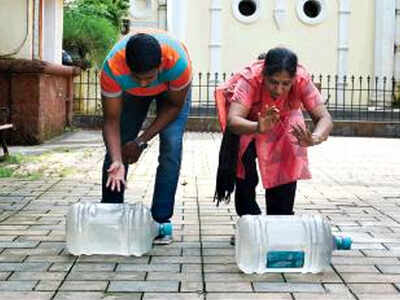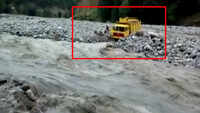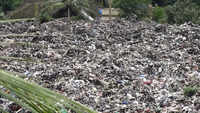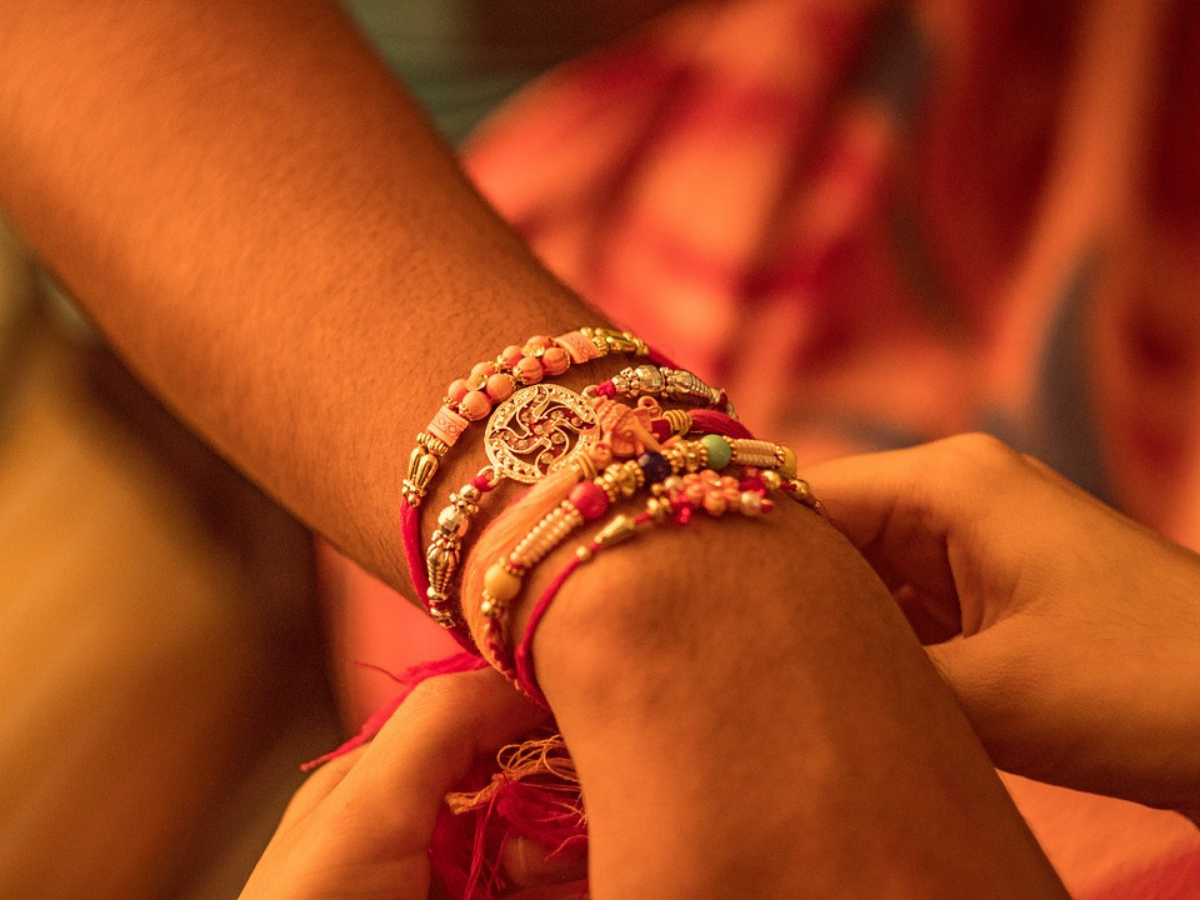
PANAJI: With taps running dry for the third day in a row in Tiswadi, residents resorted to desperate measures, which included drawing water from dirty springs and creeks. Though tankers did brisk business, demand outweighed supply and people were even seen ferrying water pots on bikes.
The strongest impact of water shortage was felt in urban pockets and in slum-like dwellings such as at Chimbel where there are no wells. Rural parts of Tiswadi such as Cumbharjua, Corlim, Old Goa, Pillar, Siridao and Agasaim fared relatively better.
“People should call up the PWD office to book water tankers, which will supply water free of cost,” chief minister Pramod Sawant said when asked about the water scarcity.
However, phones at PWD’s water supply division at St Inez rang off the hook as citizens made frantic calls for water tankers. It took TOI five calls to finally get through to a PWD official and he cut the call midway to answer another call.
PWD officials said that over 350 calls for water tankers have been received by the department.
Commercial establishments, especially hotels, cornered a major share of the private tankers, leaving residents of Panaji, Chimbel, St Cruz and Merces to fend for themselves.
In Chimbel, for example, water tankers haven’t reached for three days after supply was disrupted following damage to the two water pipelines at Curti in Ponda.
“No water tanker has come here. We have to walk to the well to get water, but there are no men to do it in our family,” an elderly lady, who stays at Indiranagar in Chimbel, said.
Men were seen ferrying plastic water pots on their bikes from the Chimbel spring. “The government needs to see our suffering. Why is it that no water tankers are sent here?” asked Irshad Khan, a motorcycle pilot who stayed at home to help the family with their water predicament.
In the capital city, the situation was slightly better. Residents began to queue up early in the morning near local wells and the two popular springs — Fonte Phoenix and Boca de Vaca. While people, from as far as St Inez came to Boca de Vaca to collect water, residents of Mala and Bhatlem turned up at Fonte Phoenix to wash their clothes.
“It is the weekend and we have to wash our clothes for next week,” a CCP employee, who did not wish to be named, said.
Many residents, especially housewives, living around Mahalaxmi temple and other areas of the city were seen till late evening lining up at the springs with pitchers and buckets for clean water.
The situation, said a man as he adjusted two water pots on his motorcycle, resembles the situation a decade ago when people would fetch water from wells for their domestic needs.
Panaji has the highest per capita supply of water in the state at 310 litres per capita per day (LPCD), but the two PWD tankers that are stationed in the capital could meet the city’s requirements.
The standard norm for domestic water usage in India is 135 LPCD.
PWD officials said that the impact on St Andre constituency was limited since the parts of the constituency received water though a pipeline from the Selaulim water project.
Meanwhile, the PWD has already taken up work on war footing to repair the two damaged water pipeline bringing water from the Opa water treatment plant to Tiswadi and Ponda taluka.
Stating that supply would be restored by Monday, chief minister Pramod Sawant said, “The principal chief engineer is monitoring the situation.”
The strongest impact of water shortage was felt in urban pockets and in slum-like dwellings such as at Chimbel where there are no wells. Rural parts of Tiswadi such as Cumbharjua, Corlim, Old Goa, Pillar, Siridao and Agasaim fared relatively better.
“People should call up the PWD office to book water tankers, which will supply water free of cost,” chief minister Pramod Sawant said when asked about the water scarcity.
However, phones at PWD’s water supply division at St Inez rang off the hook as citizens made frantic calls for water tankers. It took TOI five calls to finally get through to a PWD official and he cut the call midway to answer another call.
PWD officials said that over 350 calls for water tankers have been received by the department.
Commercial establishments, especially hotels, cornered a major share of the private tankers, leaving residents of Panaji, Chimbel, St Cruz and Merces to fend for themselves.
In Chimbel, for example, water tankers haven’t reached for three days after supply was disrupted following damage to the two water pipelines at Curti in Ponda.
“No water tanker has come here. We have to walk to the well to get water, but there are no men to do it in our family,” an elderly lady, who stays at Indiranagar in Chimbel, said.
Men were seen ferrying plastic water pots on their bikes from the Chimbel spring. “The government needs to see our suffering. Why is it that no water tankers are sent here?” asked Irshad Khan, a motorcycle pilot who stayed at home to help the family with their water predicament.
In the capital city, the situation was slightly better. Residents began to queue up early in the morning near local wells and the two popular springs — Fonte Phoenix and Boca de Vaca. While people, from as far as St Inez came to Boca de Vaca to collect water, residents of Mala and Bhatlem turned up at Fonte Phoenix to wash their clothes.
“It is the weekend and we have to wash our clothes for next week,” a CCP employee, who did not wish to be named, said.
Many residents, especially housewives, living around Mahalaxmi temple and other areas of the city were seen till late evening lining up at the springs with pitchers and buckets for clean water.
The situation, said a man as he adjusted two water pots on his motorcycle, resembles the situation a decade ago when people would fetch water from wells for their domestic needs.
Panaji has the highest per capita supply of water in the state at 310 litres per capita per day (LPCD), but the two PWD tankers that are stationed in the capital could meet the city’s requirements.
The standard norm for domestic water usage in India is 135 LPCD.
PWD officials said that the impact on St Andre constituency was limited since the parts of the constituency received water though a pipeline from the Selaulim water project.
Meanwhile, the PWD has already taken up work on war footing to repair the two damaged water pipeline bringing water from the Opa water treatment plant to Tiswadi and Ponda taluka.
Stating that supply would be restored by Monday, chief minister Pramod Sawant said, “The principal chief engineer is monitoring the situation.”
Trending Topics
LATEST VIDEOS
More from TOI
Navbharat Times
Featured Today in Travel
Quick Links
Lok Sabha Election Schedule 2019Lok Sabha Election NewsDelhi Capitals teamMI team 2019Rajasthan Royals 2019RCB team 2019Maharashtra Lok Sabha ConstituenciesBJP Candidate ListBJP List 2019 TamilnaduShiv Sena List 2019AP BJP List 2019Mamata BanerjeeBJP List 2019 MaharashtraPriyanka GandhiBJP List 2019 KarnatakaAMMK Candidate List 2019BJP List 2019 WBLok Sabha Elections in Tamil NaduBSP List 2019 UPNews in TamilLok Sabha Poll 2019Satta Matka 2018PM ModiMahagathbandhanNagpur BJP Candidate ListChandrababu NaiduTamil Nadu ElectionsUrmila MatondkarNews in TeluguMadras High CourtTejashwi YadavArvind KejriwalTejasvi SuryaPawan KalyanArvind KejriwalYogi AdityanathJaya PradaSatta King 2019Srinagar encounter
Get the app







